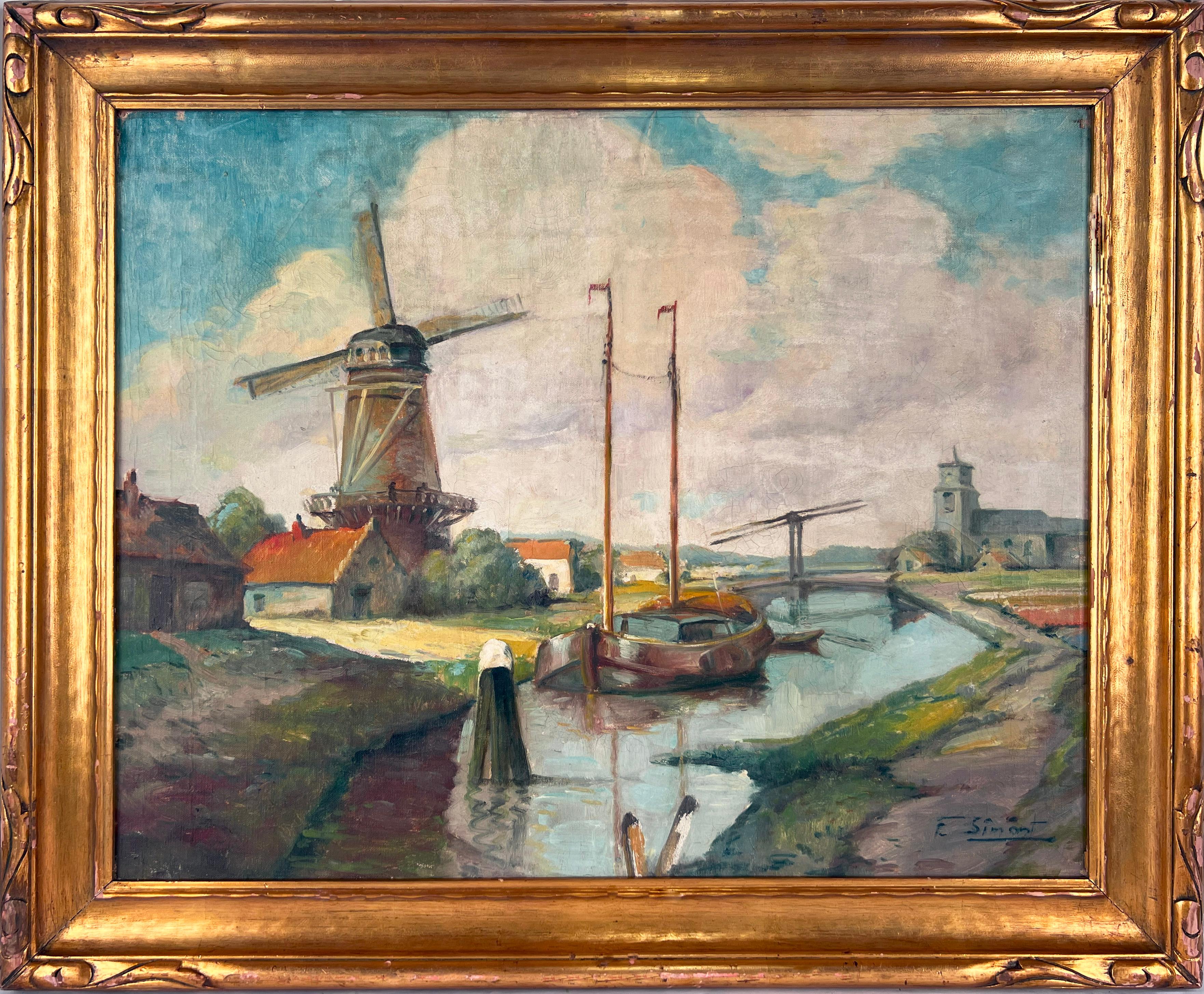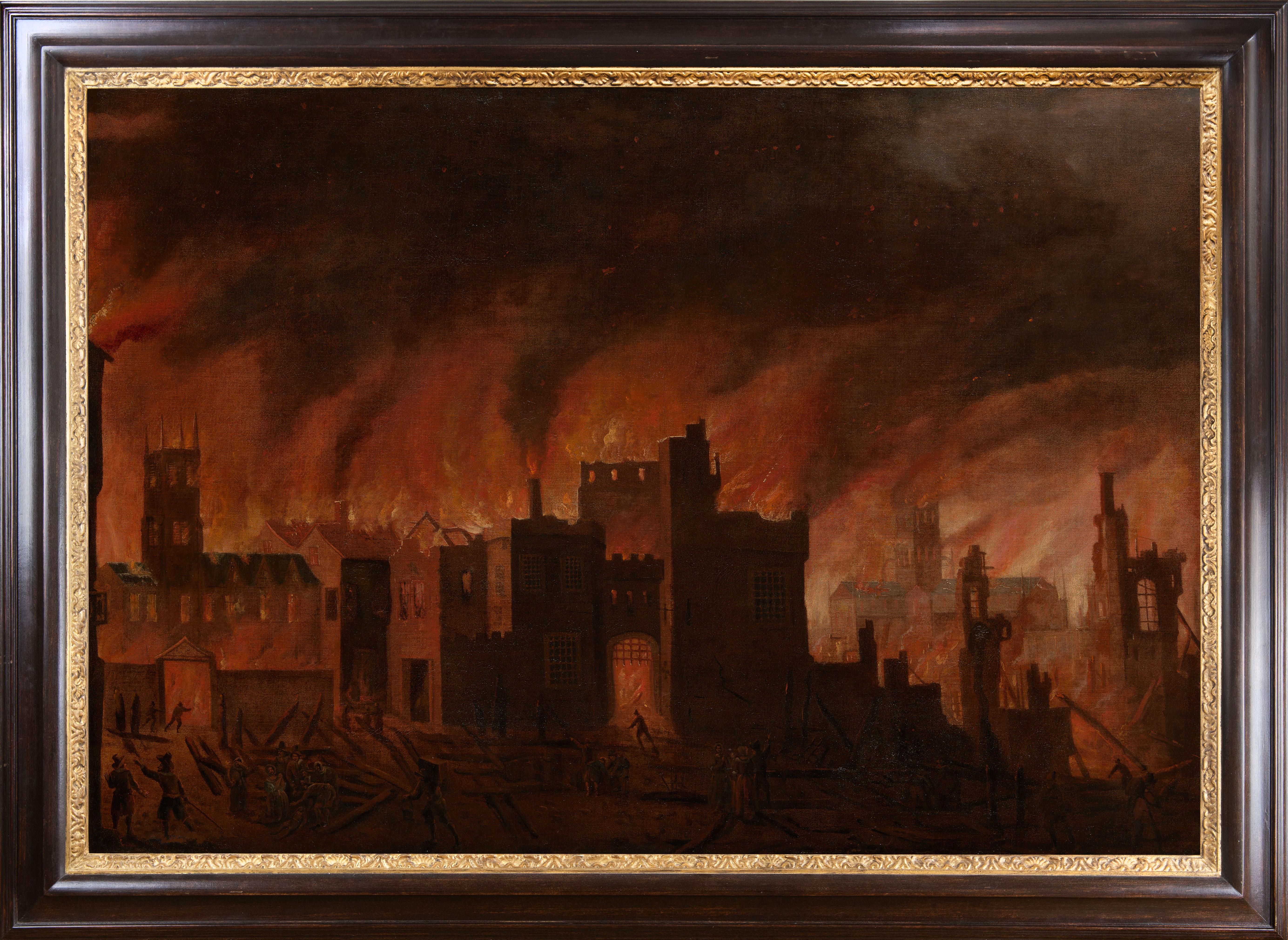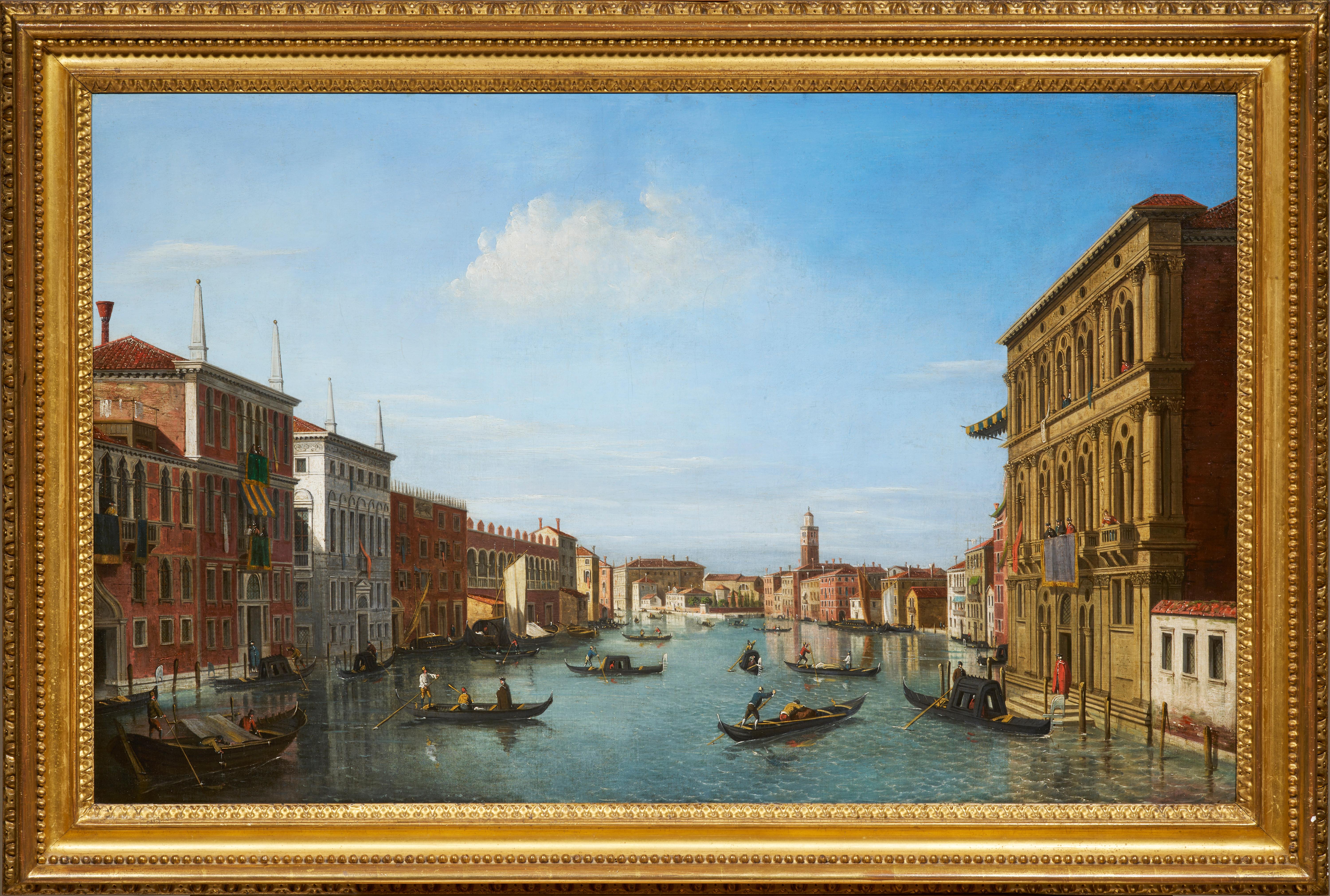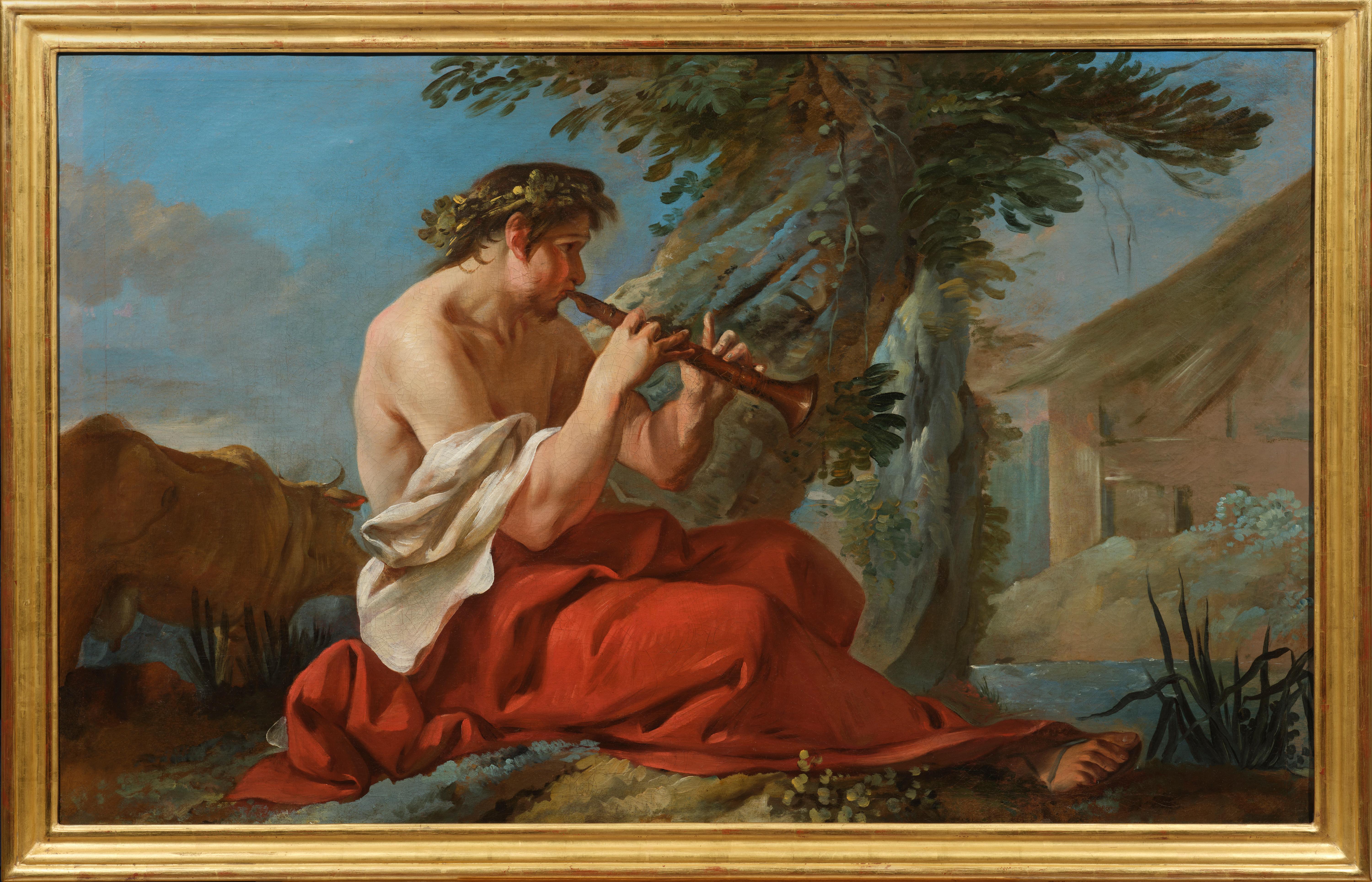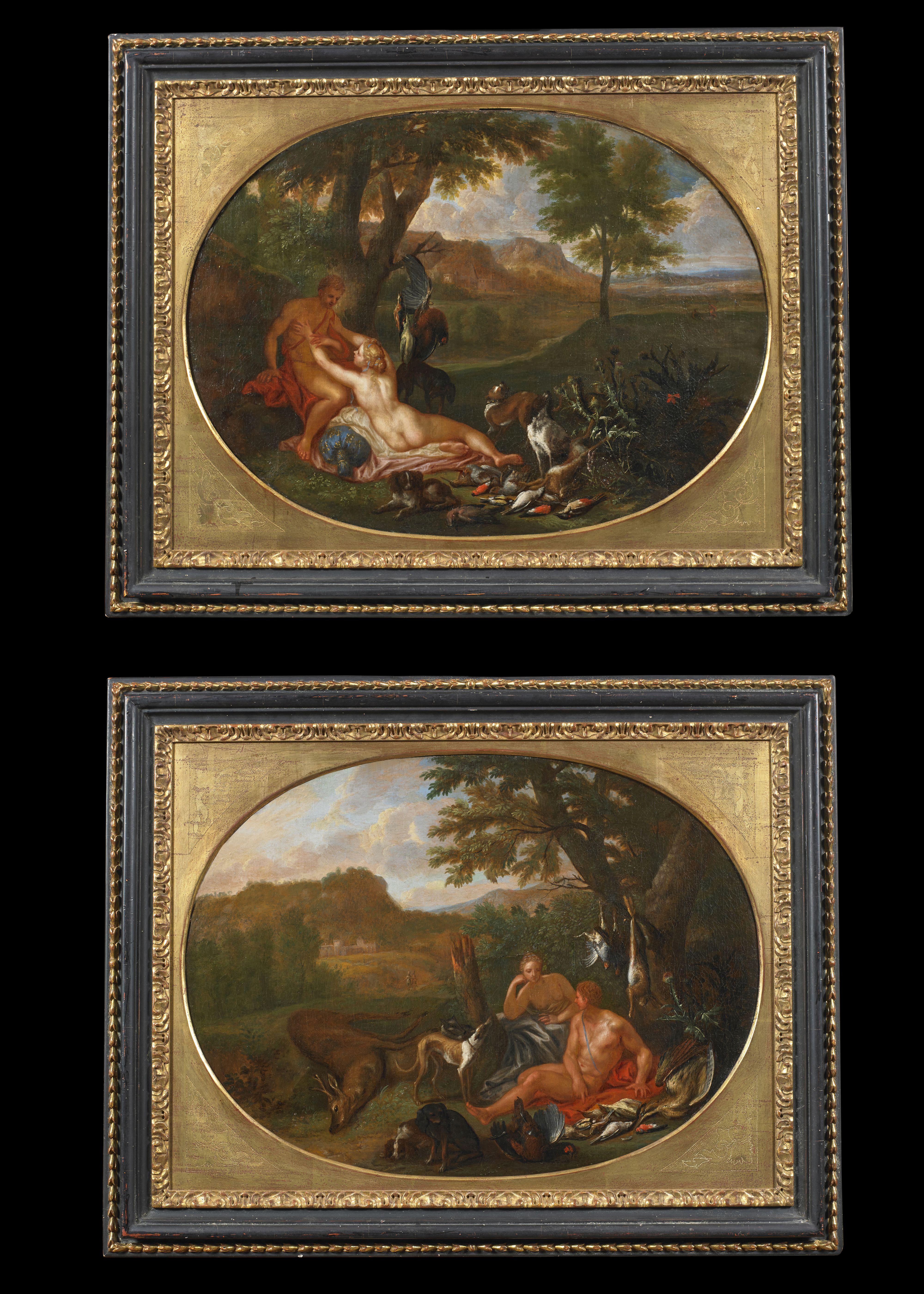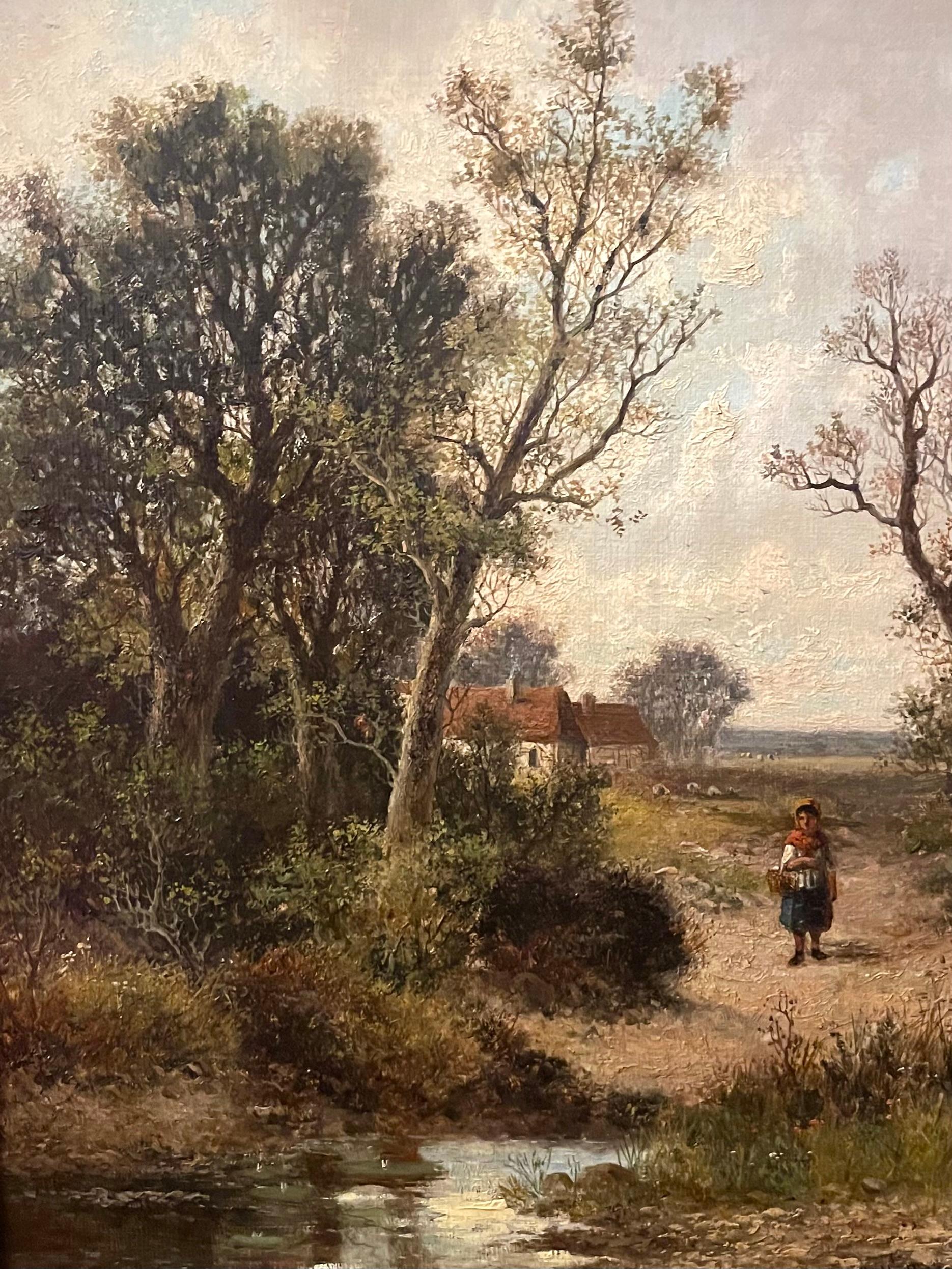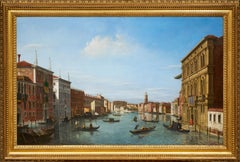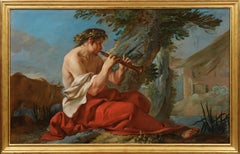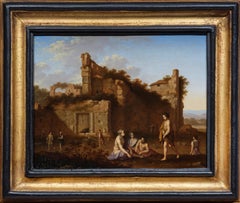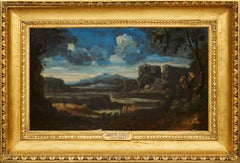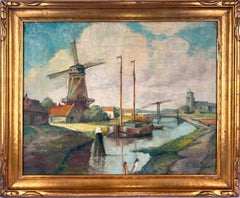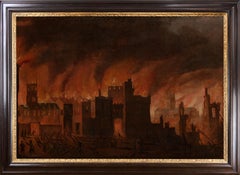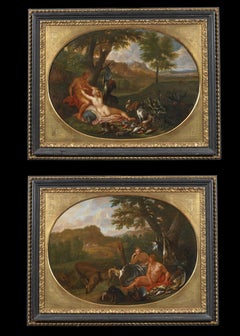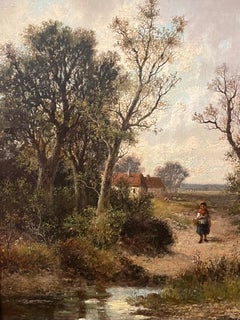Items Similar to Panoramic View of an Estate on the edge of the Sonian Forest (near Brussels)
Video Loading
Want more images or videos?
Request additional images or videos from the seller
1 of 15
Studio of Lucas van UdenPanoramic View of an Estate on the edge of the Sonian Forest (near Brussels)ca. 1650
ca. 1650
On Hold
$119,380.35
On Hold
£87,982.84
On Hold
€100,000
On Hold
CA$163,405.43
On Hold
A$183,022.72
On Hold
CHF 95,232.81
On Hold
MX$2,222,798.17
On Hold
NOK 1,207,310.03
On Hold
SEK 1,139,186.95
On Hold
DKK 761,065.22
Shipping
Retrieving quote...The 1stDibs Promise:
Authenticity Guarantee,
Money-Back Guarantee,
24-Hour Cancellation
About the Item
This museum-sized painting takes us over an estate on the outskirts of the Sonian Forest near Brussels, temptingly identified as the Ter Coigne estate in Watermael (of which only some heavily modified buildings remain today).
This gigantic "bird's eye view" is certainly a workshop painting, executed around 1650 by several artists under the supervision of Lucas van Uden, as this painting incorporates several elements characteristic of his paintings. It depicts a landscape with vast horizons, illuminated by the setting sun breaking through the clouds, stretching from the edge of the Sonian Forest to the gates of Brussels.
1. Lucas van Uden, one of the Flemish landscape masters of the 17th century
Lucas van Uden was a Flemish painter, draughtsman and engraver. He was the son of Artus van Uden (b. 1544), painter to the city of Antwerp, and the grandson of Pieter van Uden, founder of the city's famous tapestry and silk factory. Lucas was probably trained by his father. Around 1626 (age 32), he joined the Antwerp Guild of Saint Luke as a "master's son".
For most of his life, he lived in Antwerp, except for a short period around 1650, when he probably came to Brussels, and during which our picture would have been painted. He enjoyed great success during his lifetime, living in the center of Antwerp in a comfortable house with his eight children. Although he never frequented Rubens' studio, the influence of the latter's work was decisive for Lucas van Uden, who made numerous copies after the great Antwerp master, such as this Landscape with a Rainbow, painted around 1635-1640 and preserved in Vienna, and enlivened many of his compositions with a rainbow.
2. The influence of Lucas van Uden
Our painting seems to us to be a workshop composition in which several hands are recognizable, particularly in the figures in the foreground. But behind this studio work, the influence of Lucas van Uden seems perceptible, particularly in the overall composition and atmospheric elements.
Most of van Uden's paintings are constructed according to the same blueprint. The foreground usually consists of an embankment surmounted by a few tall trees with transparent foliage. These trees are illuminated from behind, with yellow-orange highlights on the tips of their branches. Arranged in small groups, they are often leaning sideways, towards the center of the panel. We find this characteristic in the mound at the left of our composition (3d and 4th photos in the gallery).
4. Description of the landscape
Beyond a mound rising at the right of the composition and occupied by a group of hunters with their dogs (3d and 4th photos in the gallery), the composition can be summed up as the alternation of two large pictorial spaces: a mosaic of woods and fields, in the middle of which the manor house stands out, and the great mass of a cloud-laden sky, which occupies the upper third of the composition and creates a kind of mirror play between the clouds and the darker areas of the landscape.
While the sky to the left of the composition is ablaze with the setting sun, the last rays of the sun illuminate the surroundings of the manor house (8th photo in the gallery) and the hunters gathered with their hounds on the front right mound, while the right-hand side of the landscape is already sinking into night. This sweep of the landscape by the sun's last rays, as daylight inexorably fades, introduces a subtle dynamic into the composition and suggests an elegiac atmosphere, making the fleetingness of the present moment palpable.
Several details enliven the landscape. In the foreground on the left, we discover a bucolic environment in which a cowherd plays his pipe on the edge of a pond, surrounded by his herds, with his dog as his sole audience (7th photo).
A little to the right, a man is busy shelling the first walnuts, suggesting that we are in the early stages of autumn (6th photo); a cart (another motif perhaps inspired by Rubens, who used it in many landscapes) emerges at the end of a sunken lane (6th photo).
The skyline reveals the city of Brussels on the far left, dominated by the slender silhouette of the Town Hall tower (11 and 12th photos).
5. Proposed estate identification
Strategically placed near a pond (8th photo), the manor house in our painting is undeniably a pleasure residence. It is situated at the heart of a quadrilateral surrounded by a white-water moat, accessed by a drawbridge leading to a crenellated gatehouse. The garden surrounding the manor house, built in the heart of this quadrilateral, is structured into four large squares, three of which are themselves subdivided into four parterres de broderies. Three of the corners are occupied by small pleasure pavilions built over the moat. The well in front of the manor, the wall extending the entrance châtelet to the right and the gabled building built along the moat could be the remains of a former fortified feudal residence.
With the help of the Association du Patrimoine Artistique, we propose to compare this manor house with that of Ter Coigne in Watermaele (a suburb of Brussels).
6. Framing
Our painting is presented in an early 20th century blackened wooden frame, simply adorned with a gold band around the view.
Main bibliographical references :
Sander Pierron - Histoire de la forêt de Soigne [sic], Brussels, Imp. scientifique Charles Bulens, 1905
Le paysage Brabançon au XVIIème siècle - catalog of the exhibition held at the Musée d'art ancien de Bruxelles from October 13 to December 5, 1976.
La Forêt de Soignes - art et histoire - des origines au XVIIIème siècle - catalog of the exhibition held at the Château de Trois-Fontaines in 1987
Die Flämische Landschaft 1520-1700 - catalog of the exhibition held at the Villa Hügel in Essen from August 23 to November 30, 2003 and at the Kunsthistorisches Museum in Vienna from December 23, 2003 to April 12, 2004
Alan Rubin & Denis Harrington In Search of a Lost Landscape Louis XIV's Visit to the Château de Juvisy Pelham Galleries Ltd 2010
- Creator:Studio of Lucas van Uden (1595 - 1672, Flemish)
- Creation Year:ca. 1650
- Dimensions:Height: 72.5 in (184.15 cm)Width: 101.13 in (256.88 cm)
- Medium:
- Movement & Style:
- Period:1650-1659
- Condition:62 ¾” x 91 ½” (159.5 x 232.5 cm) - Framed: 72 ½” x 101 1/8” (184 x 257 cm) Early 20th century frame in blackened and gilded wood Provenance: Private collection, Belgium.
- Gallery Location:PARIS, FR
- Reference Number:1stDibs: LU1568215907202
About the Seller
5.0
Vetted Professional Seller
Every seller passes strict standards for authenticity and reliability
Established in 2020
1stDibs seller since 2021
10 sales on 1stDibs
Typical response time: 2 hours
- ShippingRetrieving quote...Shipping from: PARIS, France
- Return Policy
Authenticity Guarantee
In the unlikely event there’s an issue with an item’s authenticity, contact us within 1 year for a full refund. DetailsMoney-Back Guarantee
If your item is not as described, is damaged in transit, or does not arrive, contact us within 7 days for a full refund. Details24-Hour Cancellation
You have a 24-hour grace period in which to reconsider your purchase, with no questions asked.Vetted Professional Sellers
Our world-class sellers must adhere to strict standards for service and quality, maintaining the integrity of our listings.Price-Match Guarantee
If you find that a seller listed the same item for a lower price elsewhere, we’ll match it.Trusted Global Delivery
Our best-in-class carrier network provides specialized shipping options worldwide, including custom delivery.More From This Seller
View AllView of the Grand Canal, a painting by William James, after Canaletto
By William James
Located in PARIS, FR
Although we have little bibliographical information on William James, we know that he was trained by Canaletto during the painter's stay in England between 1746 and 1755. Although he may never have been to Venice, William James remained under the influence of his master for a long time and became known for his paintings inspired by Canaletto's artworks.
In this painting, William James is inspired by one of the twelve views of the Grand Canal painted by Canaletto for Joseph Smith, or more precisely by the engraving made by Antonio Visentini in 1735 after this painting. He delivers a very personal version, vibrant with colours, in which he brilliantly reproduces the moving surface of the sea, animated by the ever-changing traffic of the gondolas.
1. William James, the English follower...
Category
Mid-18th Century Old Masters Landscape Paintings
Materials
Canvas, Oil
Mercury and Io, a rediscovered painting by Jean-Baptiste Marie Pierre (ca. 1740)
Located in PARIS, FR
We would like to thank Mr. Nicolas Lesur for confirming the autograph nature of the entire composition after a direct examination of the painting on November 27, 2024.
This painting...
Category
1740s Old Masters Figurative Paintings
Materials
Canvas, Oil
Gathering in antique Ruins, a monogrammed painting by Jan van Haensbergen
By Jan Van Haensbergen
Located in PARIS, FR
Jan van Haensbergen was a painter of the Dutch Golden Age and a pupil of Cornelius van Poelenburgh (Utrecht 1594 - 1667). The painting we are presenting is inspired by Poelenburgh’s landscapes from his Italian sojourn. The dreamlike atmosphere of this Gathering in antique ruins appealed to us. Against a backdrop of antique ruins, three draped characters (perhaps bathers) are sitting in a circle, greeting a fourth character walking towards them.
Their tranquility contrasts with the bustle of the other characters in the background. They constitute a vivid illustration of otium, this leisure time that allows us to realize our full potential. With this Arcadian landscape, Jan van Haensbergen invites us in turn to leave the hustle and bustle of everyday life behind, to take a break, to enjoy the present moment chatting with close friends…
1. Jan van Haensbergen, a landscape and portrait painter of the Dutch Golden Age
Jan van Haensbergen was born in 1642 in Gorinchem, a town in southern Holland to the east of Rotterdam. He was a pupil of Cornelius van Poelenburgh, and began by painting landscapes inspired by those of his master, in an Italianate style. Between 1668 and 1669, he was registered at the Guild of Saint Luke in Utrecht.
In 1669, he moved to The Hague, where he joined the Confrérie Pictura, an artist society founded in 1656. His portraits, which became his main activity as a painter after settling in The Hague, were strongly influenced by Caspar Netscher (Prague or Heidelberg 1639 - The Hague 1684), whom he met in The Hague and whose son Constantijn became his son-in-law by marrying his daughter Magdalena.
In addition to his work as an artist, Van Haensbergen was also an art dealer, probably helped by his appointment as Dean of the Confrérie Pictura, where he also teached.
2. Description of the artwork and related paintings
This painting seems to us to be a kind of allegory of otium, that quiet bliss promised by Epicurus. It might even evoke an Epicurean proverb: "It is better to lie on the naked ground and be at ease, than to have a golden carriage and a rich table and be worried" .
Three draped young people - two men and a woman in the background - are seated in a circle, greeting a fourth figure walking towards them, hair disheveled and body draped in a towel as if drying off after a bath, indicating the need for prior purification to fully enjoy this rest. Their nonchalance contrasts with the bustle of the various characters in the background.
The composition is punctuated by successive diagonals, and opens onto a landscape on the right, with a succession of mountainous planes. This painting is typical of the Italianate works produced by Van Haensbergen in the 1660s under the influence of Cornelis van Poelenburgh...
Category
17th Century Old Masters Landscape Paintings
Materials
Oak, Oil
Italian Landscape with Jack Players, a painting by Gaspard Dughet (1615 - 1675)
By Gaspard Dughet
Located in PARIS, FR
Here Gaspard Dughet offers us an idyllic vision of the Roman countryside. The stages follow one another in a perfectly structured composition, revealing here a lake, there travellers walking along, gradually leading our eye to the blue horizon. But behind its classical composition, this landscape is particularly interesting because of three anthropomorphic details that the artist has hidden, opening the way to a radically different interpretation...
1. Gaspard Dughet, a landscape artist in the light of Poussin
Gaspard Dughet was born on June 4th, 1615 in Rome where his father, of French origin, was a pastry cook. He was probably named Gaspard in honour of his godfather Baron Gaspard de Morant, who was, or may have been, his father's employer. His older sister Jeanne married the painter Nicolas Poussin (1594 - 1655) on September 1st, 1630. The young Gaspard was apprenticed with his brother-in-law at the beginning of 1631, which led his entourage to name him Gaspard Poussin. The first preserved works of the painter date from the years 1633-1634 and were painted in Poussin’s studio.
Around 1635, Gaspard Dughet became emancipated and began to frequent the Bamboccianti circle. In 1636, he became friends with the painter Jean Miel (1599 - 1656), but also with Pier Francesco Mola (1612 - 1666) and Pietro da Cortona (1596 - 1669).
This was also the time of his first trips throughout Italy. The painter, although of French origin, appears never to have visited France. In 1646 he settled permanently in Rome. A recognized painter with a solid book of orders, he remained faithful to landscape painting throughout his life, alternating between cabinet paintings and large decorative commissions, using both oil and fresco.
Nailed to his bed by rheumatic fever at the age of 58, he died on May 25, 1675.
2. Discovering an idealized landscape
Beyond a relatively dark foreground that takes us into the landscape, we discover a vast bluish horizon: a plateau surrounded by deep ravines advances to the right, overhanging an expanse of water that sparkles below. A road winds through a mountainous mass as if leading us to the fortress that crowns it; another town appears in the distance at the foot of three conical mountains.
The composition is rigorous, mineral, and structured by geometric volumes. The various stages in the landscape lead one to the next attracting the eye towards the horizon located in the middle of the canvas. The general impression is that of a welcoming and serene nature.
In many places the paint layer has shrunk, or become transparent, revealing the dark red preparation with which the canvas was covered and accentuating the contrasts.
Human presence is limited to three jack players, leaning against a mound in the foreground. Their long garments, which may evoke Roman togas, contribute to the timelessness of the scene.
Close examination of the canvas reveals two other travellers on the path winding between the rocks. Made tiny by the distance, their introduction in the middle register, typical of Dughet's art, lengthens the perspective.
While it is difficult to date the work of a painter who devoted his entire life to the representation of landscapes, it is certain that this painting is a work from his later years. The trees that occupied the foreground of his youthful compositions have been relegated to the sides, a stretch of water separates us from the arid mountains counterbalanced by two trees represented on the opposite bank. The introduction of this stretch of water in the middle of the landscape betrays the influence of the Bolognese and in particular of the Dominiquin (1581 - 1641)
A number of similarities with a drawing in the British Museum might suggest a date around 1656-1657, since, according to Marie-Nicole Boisclair , it has been compared with the Prado's Landscape with the Repentant Magdalene, painted at that period.
3. Three amazing anthropomorphic details
While some late Renaissance landscapes offer a radical double reading, allowing one to see both a face or a human body behind the representation of a landscape, it seems interesting to us to hypothesize that Gaspard Dughet had fun here by slipping in a few details that, taken in isolation, evoke human or animal figures.
We will give three examples, looking closely at a cloud, the trunk of a broken tree and the top of a cliff.
The main cloud could thus evoke a Christ-like face or that of an antique god...
Category
1650s Old Masters Landscape Paintings
Materials
Oil
Stag Hunting in the Vicinity of Nuremberg by a German Artist Peter von Bemmel
Located in PARIS, FR
This small landscape shows a hunting scene: two riders are chasing a stag with their dogs at the edge of a forest. Signed by Peter von Bemmel, it is typical of the production of this...
Category
1720s Old Masters Landscape Paintings
Materials
Copper
River Landscape with Shepherds and Architecture, a painting by Jan van Bunnik
By Jan van Bunnik
Located in PARIS, FR
This painting has been the subject of a study by the art historian Fabrizio Dassie (available on request), confirming its inclusion in Jan van Bunnik’s corpus.
In this painting, Ja...
Category
Late 17th Century Old Masters Landscape Paintings
Materials
Copper
You May Also Like
Mid Century Dutch Windmill Original Oil in Dutch Impressionist Style
Located in Soquel, CA
Mid Century Dutch Windmill Original Oil in Dutch Impressionist Style
Colorful French impressionist style oil painting by F. Simont (Dutch 19th/20t...
Category
1950s Old Masters Landscape Paintings
Materials
Linen, Oil, Stretcher Bars
Early oil depicting the Great Fire of London
Located in London, GB
The Great Fire of London in September 1666 was one of the greatest disasters in the city’s history. The City, with its wooden houses crowded together in narrow streets, was a natural fire risk, and predictions that London would burn down became a shocking reality. The fire began in a bakery in Pudding Lane, an area near the Thames teeming with warehouses and shops full of flammable materials, such as timber, oil, coal, pitch and turpentine. Inevitably the fire spread rapidly from this area into the City. Our painting depicts the impact of the fire on those who were caught in it and creates a very dramatic impression of what the fire was like. Closer inspection reveals a scene of chaos and panic with people running out of the gates. It shows Cripplegate in the north of the City, with St Giles without Cripplegate to its left, in flames (on the site of the present day Barbican). The painting probably represents the fire on the night of Tuesday 4 September, when four-fifths of the City was burning at once, including St Paul's Cathedral. Old St Paul’s can be seen to the right of the canvas, the medieval church with its thick stone walls, was considered a place of safety, but the building was covered in wooden scaffolding as it was in the midst of being restored by the then little known architect, Christopher Wren and caught fire. Our painting seems to depict a specific moment on the Tuesday night when the lead on St Paul’s caught fire and, as the diarist John Evelyn described: ‘the stones of Paul’s flew like grenades, the melting lead running down the streets in a stream and the very pavements glowing with the firey redness, so as no horse, nor man, was able to tread on them.’
Although the loss of life was minimal, some accounts record only sixteen perished, the magnitude of the property loss was shocking – some four hundred and thirty acres, about eighty per cent of the City proper was destroyed, including over thirteen thousand houses, eighty-nine churches, and fifty-two Guild Halls. Thousands were homeless and financially ruined. The Great Fire, and the subsequent fire of 1676, which destroyed over six hundred houses south of the Thames, changed the appearance of London forever. The one constructive outcome of the Great Fire was that the plague, which had devastated the population of London since 1665, diminished greatly, due to the mass death of the plague-carrying rats in the blaze.
The fire was widely reported in eyewitness accounts, newspapers, letters and diaries. Samuel Pepys recorded climbing the steeple of Barking Church from which he viewed the destroyed City: ‘the saddest sight of desolation that I ever saw.’ There was an official enquiry into the causes of the fire, petitions to the King and Lord Mayor to rebuild, new legislation and building Acts. Naturally, the fire became a dramatic and extremely popular subject for painters and engravers. A group of works relatively closely related to the present picture have been traditionally ascribed to Jan Griffier...
Category
17th Century Old Masters Landscape Paintings
Materials
Oil, Canvas
18th Century Galanti Scenes Van Limborch Rest Hunting Oil on Canvas Green Red
Located in Sanremo, IT
Pair of oval paintings measuring 66 x 89 cm without frame and 90 x 115 cm with coeval frame depicting two gallant moments during a rest from hunting by painter Hendrik Van Limborch (...
Category
1730s Old Masters Landscape Paintings
Materials
Canvas, Oil
Landscape Near Felday, Surrey
By Abraham Hulk the Younger
Located in Hillsborough, NC
Dutch/English artist Abraham Hulk the Younger (1851-1922) is most known for landscapes of the British countryside. This work is one of a pair (the second work is also available by s...
Category
Late 19th Century Old Masters Landscape Paintings
Materials
Canvas, Oil
$2,240 Sale Price
20% Off
View of Ponte Milvio in Rome
Located in Roma, RM
Northern painter active in Rome in the second half of the 17th century, View of Ponte Milvio
Oil painting on canvas 73 x 97 cm in coeval Roman Salvator Rosa frame.
Category
18th Century and Earlier Old Masters Landscape Paintings
Materials
Canvas, Oil
A 17th c. Italian school, Capriccio with the Colosseum, circle of V. Codazzi
Located in PARIS, FR
A capriccio with the Colosseum in Roma
17th century Italian school
Circle of Viviano Codazzi (1604-1670)
Oil on canvas
Dimensions: h. 35.43 in, w. 51.18 in
Modern 17th century style ...
Category
17th Century Old Masters Landscape Paintings
Materials
Canvas, Oil
More Ways To Browse
Vintage California Road Sign
Yellowstone National Park
Bloomsbury Painting
California Cypress
Cargo Ship Painting
Eiffel Tower Paintings
French Alps Landscape
Impressionist Painting Flags
J Harrison
Nicholas Robert
Oil Painting Of Harbor 19th Century
Oil Tank
The Vintage Fort
Bucks County Impressionists
Paris Street Scene Painting Large Canvas Painting
Peruvian Watercolour
Robert Klein Gallery
Roman Ruins Painting
